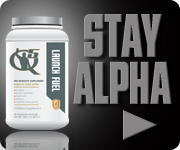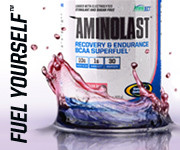by Mason McClellan LAc
I am an Licensed Acupuncturist in Minneapolis and mainly use acupuncture, herbs and dietary therapy as my primary therapy tools. Recently, I have incorporated Muscle Tape into my practice for the athletes that I treat. I find it to be a fantastic passive therapy that does a few things to make my work even more effective. I want to show you a few case studies in how I use it and what I do that is a little different in the way I look at pain and injuries.
(I have been training BJJ and Mixed-Martial Arts since the mid-90's starting my training under the famed MMA coach Greg Nelson and more recently with Greg's protege' and Pedro Sauer Black Belt Tom Schmitz at Spartan Martial Arts in Oakdale MN.)
So I see a lot of nagging injuries around the gym and I want to show you a way to better way to use the S1 Muscle Tape to improve the therapeutic outcome.
A few reasons to use S1 Muscle Tape
a. Promotes blood flow and extends healing effect of my primary therapy
b. Stabilizes/supports the inured or painful area
c. Reminder, to take it easy on the injured area so even if you feel good you are mindful to keep intensity down so it heals properly
Case I: (Adam gave me permission to use his case in this regard as to not violate patient privacy laws)
He credits the Muscle tape as a major factor in his recovery!
29yo M
Chief complaint: Excruciating Left SI-joint pain
Adam is an accomplished lifter, USAF Security Forces vet and one of the strongest grip athletes in the world, more here. So when he comes in a day after taking 5 minutes to get out of his car and with a significant limp, I know he is hurting. And by the time I see him he has been like this for a week. Pain meds aren't working, PT says SI-dysfunction with rotation of the lumbar, but basically he can't walk or move right and has about no forward flexion at the waist.
a. Note lack flexion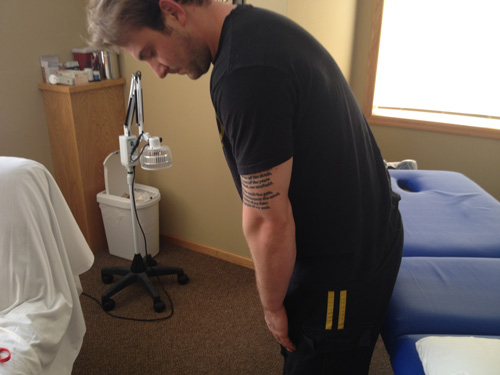
b. So we did local points to relax the painful areas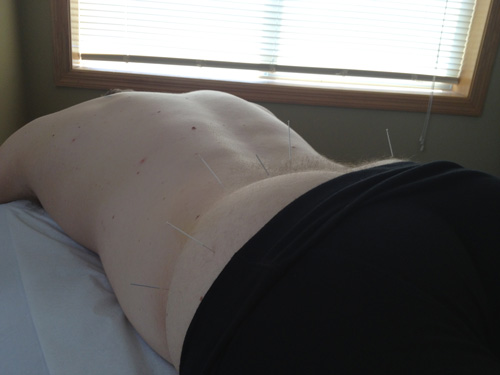
c. Adam notices about 30% improvement in pain levels and a slight improvement in flexion. I am not satisfied so I look elsewhere and in this case we go down the backline on the left hamstring, we call it the Bladder line/channel/meridian in acupuncture. Basically what Thomas Myers of Anatomy Trains calls the deep back line, the interconnectedness of muscles/fascia/connective tissue. We find a tender/trigger point, what we call an Ashi point. So we needle deep into the hamstring, watch what happens...
(note the needle in the left hamstring) 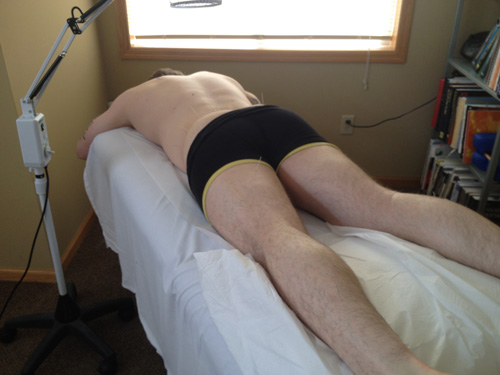
d. In analyzing the case Adam had no flexion and intense pain with straight legs, bent legs he could bend forward, voila! You got a hamstring problem!!!
e. Notice the improvement with bent legs...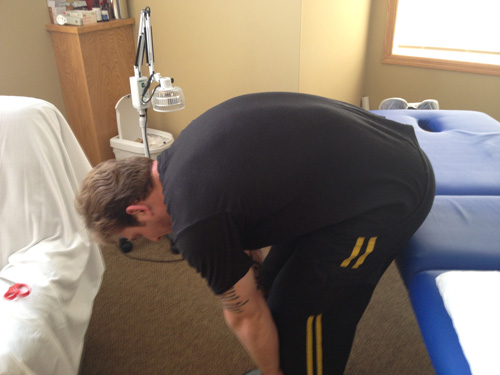
f. So now we tape and lock in our improvement. I just use simple lines down the paraspinals and over the SI, over the glute medius, and of course the hamstring dysfunction that we uncovered!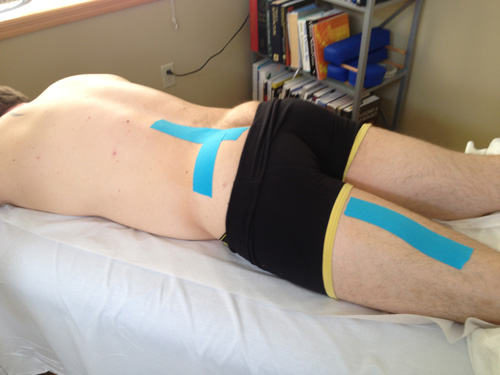
So the difference is that Adam had no pain in the hamstring and didn't think that was the issue. But had we just taped the SI joint we would have been missing, you gotta look! Adam reported some major releases to his SI/low back area and really liked the tape and thinks that made all the difference in the world and is going to add it to his gym's offering.
We treated Adam a few more times and by his 3rd visit/day he was walking normal and back to his old strong self, not perfect but he was at about 30% before and in 3 treatments over 3 days he was back to 85%. Each day using the tape to improve and extend the the therapy.
So the BJJ, take-away is that if your elbow is tweaked, look at the shoulder too. Don't just tape the elbow! If your shoulder is jacked look at the neck or the hips...everything is connected and don't assume the painful area is the problem!
I have 2 more tape case studies in the future and maybe we can share how I use topical herbs in conjuction and internals for sports performance...
You can find/follow me here
www.AcupuncturebyMason.com
BJJ GEAR REVIEWS
blog comments powered by Disqus

